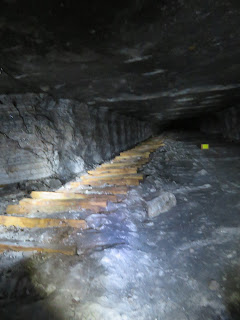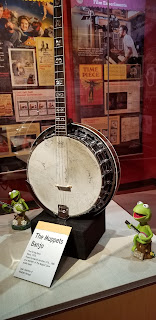Abilene, KS:
The EisenhowerPresidential Library and Museum is located in Eisenhower’s hometown of
Abilene.
The campus also includes his Boyhood
Home and Place of Meditation – Eisenhower’s final resting place. The Visitors Center sits on the original site
of Eisenhower’s elementary school. The Museum has recently been
renovated and has new exhibits that include many technology and interactive
components.
The displays of artifacts
provide insight into how Eisenhower’s experiences enabled him to best lead the
Allies to victory in Europe during WWII.
The Museum also depicts
Eisenhower’s personal life, his campaign for Presidency and his achievements
while in the White House.
Eisenhower’s Boyhood Home is
located on its original site and contains furniture and items left by his
mother.
Eisenhower, his wife Mamie
and their son Doud are buried in this beautiful chapel called the Place of
Meditation. It was Eisenhower’s wish
that visitors might use this space to reflect upon the ideals that made this
nation great and pledge continued loyalty to those ideals.
Wichita, KS:
In nearby Hutchinson, there
is a working salt mine that features a museum: Strataca – Kansas Underground Salt Museum.
We had the opportunity of going down 650 feet
into the mine and taking various modes of transportation to see deep into the
salt mines. There are displays
of mining equipment, types of salt and items left by the men who worked in
these mines.
Dynamite was used for many
years, so there are thousands of empty boxes.
Sometimes the miners piled them neatly, other times they were just
tossed.
 |
| Some boxes used to mark trails |
Trash remains in the mines as
well as equipment, furniture, and …
 |
| toilet |
Railroad ties were reused as the tracks had to be moved when the miners went deeper into the mine.
Years ago the film studios
realized the advantages of atmosphere, depth and security that the salt mine
offers for storage. The phrase “Send it
to the salt mine” was common in Hollywood’s post-production circles.
The Wichita Art Museum offered this
special exhibition during our visit.
It’s one of my very favorite exhibitions! Light and Shadow: Alyson Shotz and Kumi
Yamashita features the work of two sculptors.
These 2 pieces by Shotz are
made of nets of stainless steel wire and silvered glass beads which change
shape as the air flows.
 |
| Invariant Interval #3 by Alyson Shotz |
 |
| Equilibrium by Alyson Shotz |
Yamashita has been called
“The Magician of Shadow”. Using solid
objects and light projected to create shadow, her works truly appear magical!
 |
| Arc by Kumi Yamashita |
 |
| 0 to 9 by Kumi Yamashita |
 |
| Origami by Kumi Yamashita |
 |
| Building Blocks by Kumi Yamashita |
 |
| Question Mark by Kumi Yamashita |
Having just traveled through
the Flint Hills of Kansas, I was especially drawn to this piece in the Museum’s
permanent collection:
 |
| Flint Hills Cloudscape by Phil Epp |
More Kansas landscapes --
 |
| Early Fall, Smoky River by Birger Sandzén |
 |
| Kansas Cornfield by John Steuart Curry |
There was one gallery that
featured different aspects of Early American Life. The “Home and Family” section featured
miniature portraits, samplers and this family register. One of the sons drew his family tree using a
large circle with slivers to represent his siblings.
 |
| Reiter Family Record (ink on paper) |
I have a friend that likes
the works of Fred Wilson. Initially I
didn’t care much for some of his pieces; however, I have learned to appreciate
them as we have visited museums. I really
like this mirror work. Its size alone
(10 feet wide) gives one a feeling of a large empty stage! I also like how it reflects the beautiful
landscape outside of the museum.
 |
| Act V. Scene II – Exeunt Omnes by Fred Wilson |
Keeper of the Plains
Sculpture:
The Keeper of the Plains is
a 44-foot tall steel sculpture in downtown Wichita. It stands at the point where the Big and
Little Arkansas rivers merge. This
sculpture was created by Blackbear Bosin, a Native American artist. Suspended foot bridges from each side of the
two rivers meet at the land in between.
At the pedestal of the
sculpture stands this Circle of Life sculpture.
It represents the world to the Plains Indians – the two halves of the
circle symbolize the physical and spiritual realms of the world. The four quadrants are symbolic of the 4
seasons, the 4 directions, the 4 times of day and the 4 elements. At the center
is a circle in the shape of a turtle. The Plains Indians believed that we are
all floating on an ancient sea on the back of a turtle.
At night, there is a “Ring
of Fire” show around the Keeper of the Plains sculpture. What a lovely way to end our visit in Kansas.
Oklahoma City, OK:
I had visited Oklahoma City
before and since this was a short stay, we only had time to visit one
place. Who would have thought there would be a banjo museum in OKC! The American
Banjo Museum is the only one of its type dedicated to preserving America’s
native musical instrument.
There are over 300 banjos
here…
as well as displays telling
the history of the banjo from the beginning:
during the 20s:
through the 50s and 60s:
to current:
There is one corner devoted
to Jim Henson and the Muppets. Here is
Kermit the Frog playing a banjo along with the original banjo, signed by
celebrities that appeared on Sesame Street.
We just happened to visit
this museum during the annual Banjo Fest.
In a room upstairs, called “Your Father’s Mustache”, professional banjo
players performed every hour.
We stayed to listen to Ned
Luberecki who is not only a Radio DJ but also the 2018 IBMA (International
Bluegrass Music Association) Banjo Player of the Year! He was extremely entertaining, very
knowledgeable about banjo picking styles and music and just awesome to listen
to.
What a serendipitous
treat! 😉 😉 (DC)
We’re headed back to Texas
now. See ya’ll soon!


































